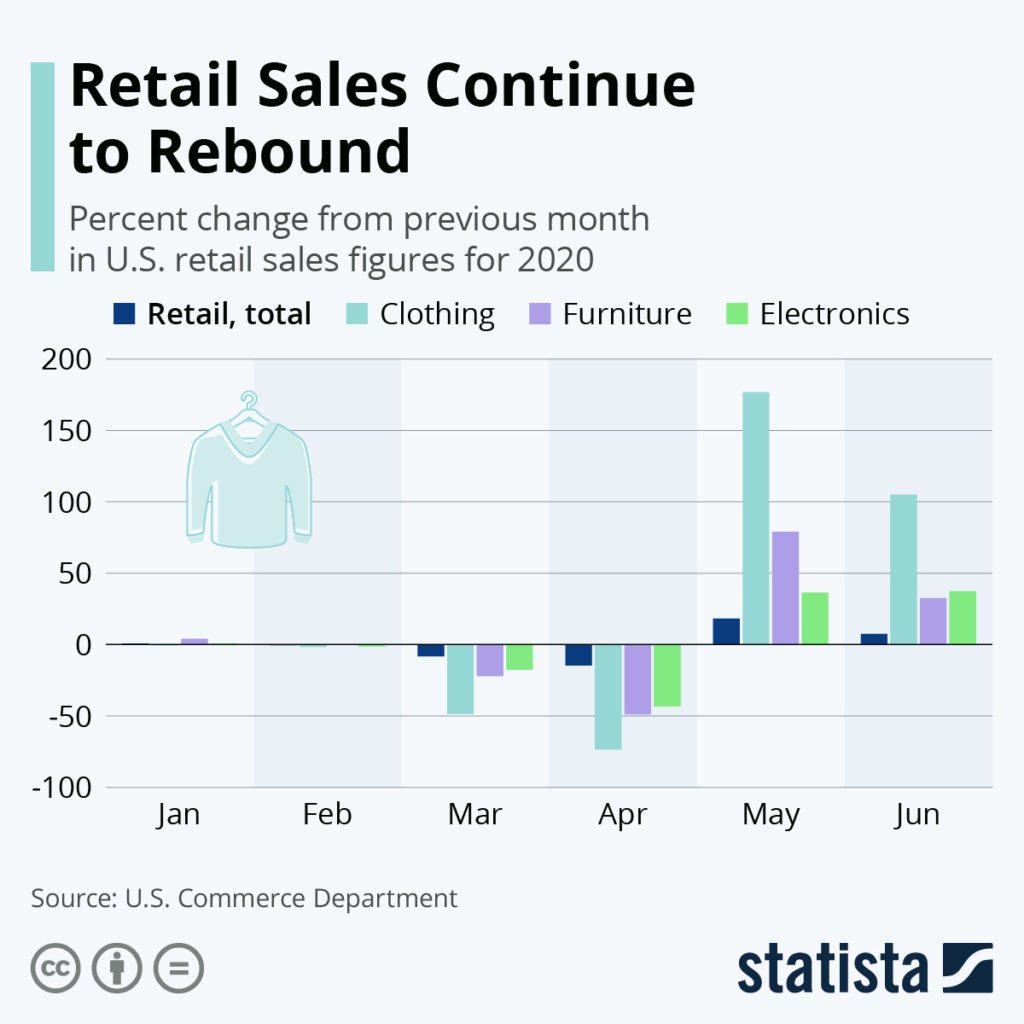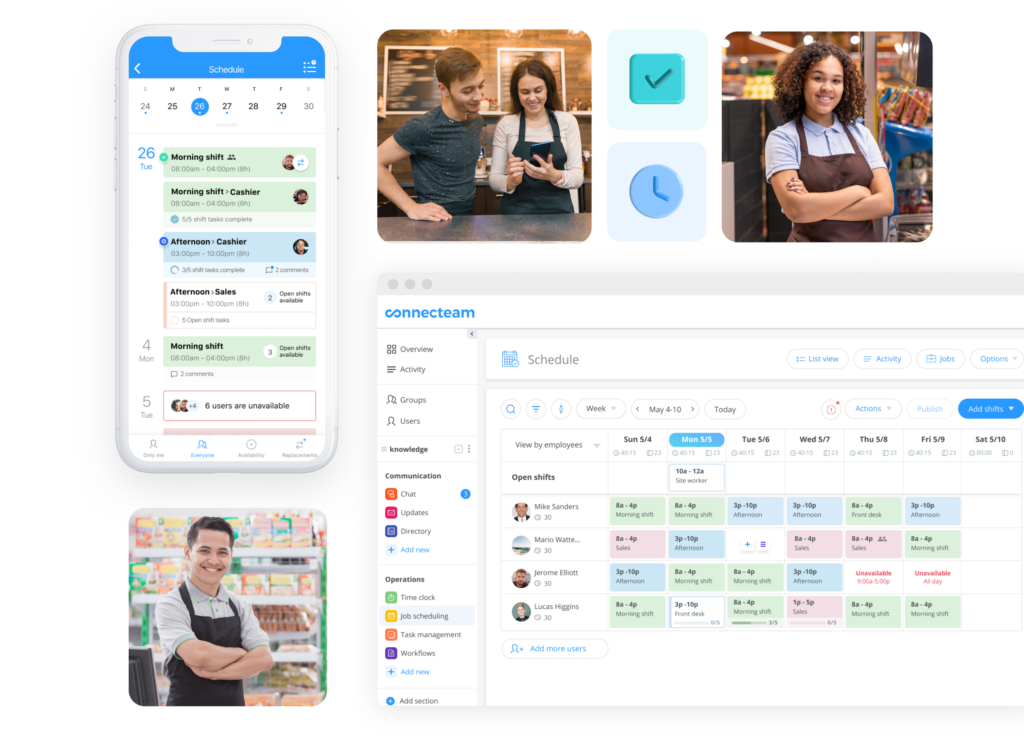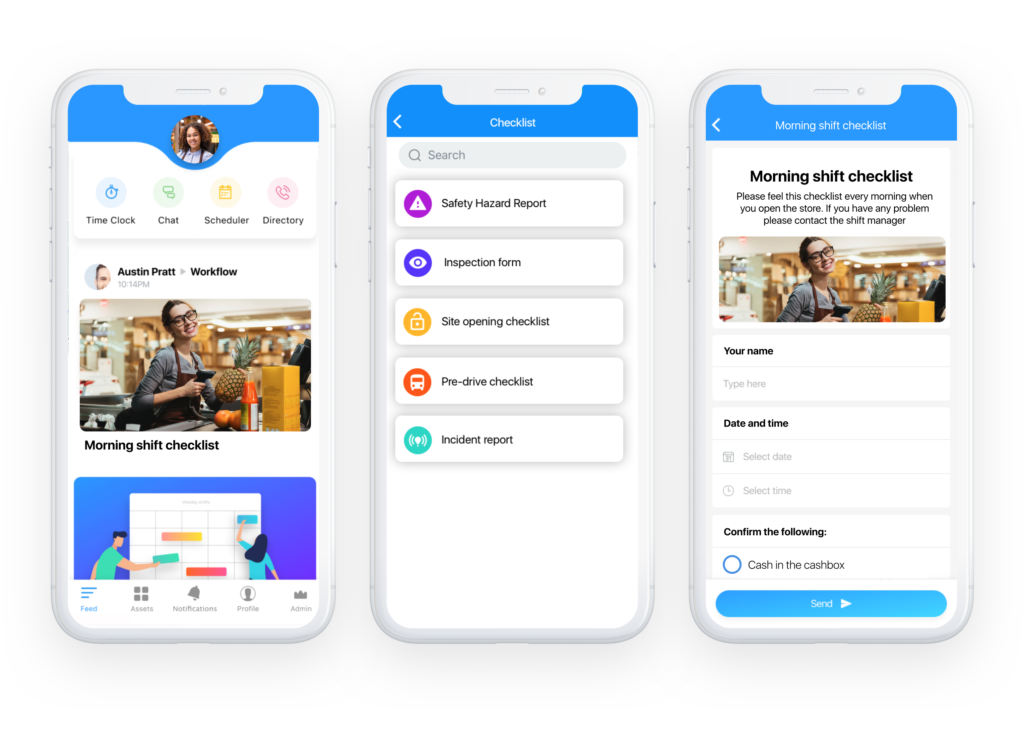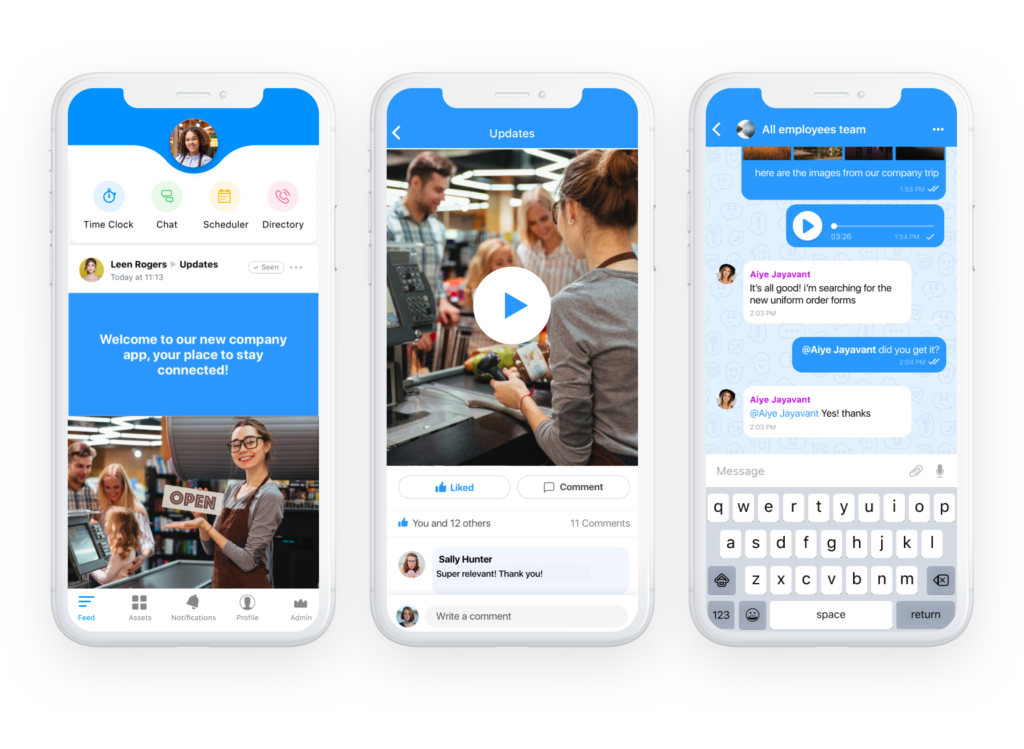Retail operations managers are often compared to store managers, yet with the long list of duties and responsibilities, you simply can’t compare! Store managers only need to ensure their physical store runs smoothly. However, retail operations managers supervise multiple stores and have a much larger workload.
Retail operations managers are expected to travel from branch to branch to analyze performance and provide pointers. The right candidate can direct sales traffic in the right direction, increase morale, improve the overall customer experience store-wide, and so much more.

With all the turmoil the pandemic has caused, retail operations have had to adapt to the new rules and regulations. Therefore, retail operation managers are looking for new ways to improve efficiency, sales, productivity, and reduce costs. The right operations manager equipped with the right tools can make all the difference in achieving these goals!
Solve everyday issues as a retail operations manager!
Connecteam helps you to manage the complexities of communication, operations management, training, etc.
Below, we dive into the challenges retail operations managers face often and how to solve them in the best way possible – often the right solution to many of these common challenges is a digital solution.
What is a Retail Operations Manager?
A retail operations manager’s job requires thinking fast on their feet. There is little room for error, as a couple of wrong moves can see your potential customer in your competitor’s store. Therefore, a retail operations manager requires good interpersonal skills as they have to hire the right candidates, train them, communicate well, schedule shifts, and far more. We have only scratched the surface on how many hats this person needs to wear.

A retail operations manager needs to work well with numbers to meet sales targets, stick to allocated budgets, allocate overtime correctly, and achieving that with pen and paper can be challenging.
Furthermore, a retail operations manager has to distribute planograms. Then they have to travel from store to store to make sure execution is accurate. With so much more to their role, here is a breakdown:
- Employee scheduling
- Appraisals
- Terminations
- Input information into POS system
- Monitor KPIs
- Set Holiday promotions
- Oversee Inventory
- Returns reports
- New collections and inventory analysis
- Performance evaluations
- Comply with data protection
- Ensuring consistent customer service
- Good relationships with the buyers, and head of retail
Challenges for Retail Operations Managers
Retail operation managers have many responsibilities and are always looking to reduce costs and improve productivity. Retail operations have a lot to juggle as they improve efficiency while keeping the end customer satisfied. We’ve covered the challenges and how to become a better manager. The challenges include:
Daily processes –
Each store has to receive the stock for their store. Therefore, if headquarters launch a new product, the stock must arrive at all stores in time for the store-wide launch. Retail operations managers have to wait for information from each store to decide the right amount of each stock.
Should the stock not move, a layout change may be needed for that particular store. When you are low-tech, you have to physically check each store to check that the shelves are according to the planogram.
Seasonal displays mean that the store may need signs and other marketing materials to go up at the right time and according to the guidelines. Retail operations managers have to wait for the branch manager to discuss how everything is getting along. All the stores must be aligned and have the same look and feel.
Internal communication –
Communication is a daily challenge, especially when your company isn’t tech-savvy. You send emails to the sales managers, including information from vendors about how to sell products. Since the message passes through many people until it reaches the sales assistant, the end message is often incorrect. You then end up with a sales assistant selling a product, not at its full potential.
Customer service –
With such fierce competition within the retail industry, customers are looking for that personalized, memorable experience. Retail operations include keeping up with the latest trends, ensuring that the service is unique so that customers don’t go to your competitor.
Employee retention –
With employee turnover being 76% in 2019, implementing the right tools can ensure that employees retain longer. Often employees leave because of insufficient training, setting unrealistic goals, not enough meetings with local managers, etc. Retail operations managers have to get it right so that employees retain and enjoy their working environment.
Employee engagement –
Employees who feel disengaged affect the brand in many ways. The end customer suffers as they are not receiving the best experience. Retail employees require encouragement and to feel part of the bigger picture to exceed. If managers are unable to do so, employees can become depressed and eventually leave.
Reporting –
Operational managers have multiple reports to fill out, which includes accuracy. With pen and paper, that can become difficult because you need to find where you saved your last records.
Reports usually include the targets, profit, and loss, sales goals, etc. They have to analyze the inventory and adjust pricing to shift old stock. Build strategies from the reports to increase profits and minimize losses. Stock count, promotional sales count – how many people used the coupon.
Safety –
Ensure that store managers are following the correct safety procedures store-wide. Employees have the right equipment, ladders to higher shelves, being careful around warehouses, lifting heavy things, and most importantly, the isles are clear of products so that customers can walk freely. You also need to review the procedures, and if necessary, offer refresher courses. This has been vital with the pandemic, as there are constant updates.
Managerial issues –
Being a good manager involves having the right tools, knowledge, and the ability to adapt to any given situation. Retail operations require consistency, training, and understanding consumer behavior. The correct strategies can encourage a team that works together to produce results.
Task management –
Retail operations managers need to set tasks from headquarters or regional managers. In addition, they have to deliver them effectively to branch managers. This includes setting priorities, as well as executing them properly. Retail operation managers have to receive information from store managers to set future tasks and adjust the priorities. Tasks can include sales, maintenance, stock management, etc.
12 Tips on Becoming the Best Retail Operations Manager
The 12 tips below cover challenges across the board. The solutions provided are for the retail operations manager using an employee app, like Connecteam. If you’re not yet using an employee app, you can tweak the solutions with what you are using right now.
Be a Good Listener
A great leader can listen well and is open to team ideas. Your workers on the floor hear customer’s feedback. Therefore, it’s vital to listen to their suggestions. After all, you are not able to be in all the stores at the same time. Adopt an open-door policy so that you can together address the challenges before they become an issue. For example, if an item is not selling and the floor staff advises you, you have the opportunity to position it somewhere else to generate sales. By knowing the information early, you can make the necessary changes. Working together will help you meet targets more efficiently.

Connecteam tip: Daily processes no longer need to feel stressful. You can set up a checklist for the store manager to be filled out before opening and closing the store. Checklists can be completed via the app. Hence, retail operations don’t need to wait around for the data.
Easily be the manager with the open door policy using the chat feature. You are able to set up smart groups by store, by teams, by floor, etc. You can message, and they can message you to gain feedback in real-time, without you having to physically be on-site! Searching for an employee no longer has to be difficult, simply open the directory and find by name or department. No need to phone and text, send a message or call directly through the app without exchanging phone numbers.
Protect Your Employees From Thieves or Dangerous Situations
You always want to ensure that your employees are aware of thieves. Workers must report to other stores how the thief looked and how they approached the store. This is in case they show up at another branch.
Safety also includes the daily checklists you have to come up with that store managers need to hand out. Before employees open up to customers, they need to fill out checklists, which include:
- Check the isles that they are clear
- Clean and dry floors
- All equipment such as ladders are stored correctly
- Etc.
Connecteam tip: If you are not yet digital, you may find yourself calling each branch to update your team about the thief. By the time you get through, the thief may have visited a couple of stores. However, with Connecteam, you can use the update feature to alert everyone store-wide in seconds. It’s that fast!
Safety checklists can be completed on the app and in real-time. If there is an issue, employees can let store managers know before it gets out of hand.
Providing Instructions at the Right Time
As a retails operations manager, you are wary that all branch managers have the right planograms, sales sheets, procedures, etc. This usually involves having to type those up, printing them, and then driving to distribute to each branch. Printing costs you a lot of money, time and is simply inefficient.
Sales assistants have to read those sheets, ensuring they are up-to-date with the latest sales or new launch. Assistants will often refer to the sheets when a customer asks the price of the sale item. The problem arises when you have only printed one sheet per branch. You are often left wondering if your assistants have even read it. Employees often spend time trying to look for it, whether it’s under a desk, with another assistant, or the worst case missing. When a customer approaches and the assistant has not yet read it, it becomes clear and ends up very unprofessional.
Connecteam tip: You can reduce costs and improve efficiency when it comes to launching products and sales. Instead of driving for hours wondering if employees have even read the sheet, open the Connecteam app and upload all your documents to the knowledge base. Every employee has access to the app from a desktop or any mobile device anytime, anywhere. There is no need for them to get annoyed looking for the sheet as all the information is in their back pocket. You can also track who has read it, and you can send a direct message via chat to any employee who hasn’t yet read it.
Notify Staff With Information From the Vendor
Currently, if the supplier updates you about a faulty product, you are required to call each store and advise them of the latest changes. Your sales manager then needs to locate all the staff and update them with the vendor’s instructions. You end up spending half your day calling all the store managers, and if they are busy, the end customer suffers. Especially if they come into the store, and the assistant has no idea what the customer wants.
Connecteam tip: Retail operations managers no longer need to call all the branches with updates. You can send messages to all the store managers via chat, which will arrive in minutes, and you can get on with the rest of your day.
Once the vendor provides instructions, you can enter those in the knowledge base and call the folder procedures. The folder can contain the supplier’s notes on how to explain the fault to the consumer, along with questions and answer digital sheets. Workers will know what to do in minutes and won’t be startled when customers start arriving. Employees also feel calmer as they have the information directly sent to them instead of waiting for the sales manager to update them.
Spot Trends Early
In retail operations, when you notice a trend, you want to notify everyone early on. By doing so, you can provide your team with the next steps or resolve them completely. When a sales manager reports a trend via phone calls and texts, it might take days before all branches are aware.
Connecteam tip: Be the manager who updates everyone in real-time. Employees can fill out the reports on the app, which arrives in seconds. You are aware of the situation without all the phone calls! Use the update feature to say x happened and let fellow employees like and comment on the post. Once you see it’s a trend, you can update the team that you have contacted the supplier. Employees can also see the status of how the situation is being handled.
Drive Sales And Encourage Engagement
Let’s face it, the most important thing is sales per day. Higher management wants to see profits. Retail operations managers look at sales figures to work out why one store has higher sales than another. You have to call the sales manager from location A to understand why location B is doing better. By the time you have collected this information, the picture may have changed.
If a recent launch has happened, headquarters may request sales per day of the new product. Therefore, you have to speak to each branch daily for a stock count. You can also provide tips for those stores that haven’t met the sales quota. When you’re working with pen and paper, working out all the numbers can take a long time. In addition, there is no incentive for sales assistants to sell. Therefore, it doesn’t encourage engagement in an industry known for high turnover.
Connecteam tip: When you are digitized, reports become far simpler. Your sales managers can report to you at the end of the day numbers via chat or a full digital report. With the data, you have a clear view of what’s working and what isn’t. Data arrives so fast so you can make changes on the same day.
Retail operations can increase engagement by using incentives, such as handing out gifts to the top five sellers of the week. You can announce the top five sellers of the week using the update feature, where other employees can like and comment. Sales assistants will want to be featured on the updates or win a gift. In addition, this could entice assistants to sell more. If a sales assistant is selling a lot of one product, colleagues can film the sales assistant to show employees how to sell. Once you send it as an update company-wide, everyone will like, comment, and bring the team together.
Least Stressful Onboarding
Starting a new job in retail can be challenging because trainees need to know about the company and its products before hitting the sales floor. The customer expects service, and won’t consider the person training. You have to ensure sales managers find sufficient time to train their new hires and provide them with sufficient knowledge. Often this takes hours and can be draining for both the sales manager and the new employee.

Connecteam tip: Onboarding no longer needs to be stressful and inefficient. Employees can be ready and confident to enter the sales floor. By adding the training materials, including pictures and videos on the knowledge base, employees can train by themselves. Once they hit the sales floor and have an issue with a procedure or POS, they open their mobile device, view the text, video, or image of the instructions, and continue with their job. There is no need for them to wait for help from sales managers. Therefore, the new assistant can deliver a professional service.
Sales managers can view and track their training progress. If they need assistance, the sales manager can message them privately on the chat.
As a retail operations manager, you have an overview of how the new employees are doing.
On The Job Training
Ongoing training means that you have to set a time where your team can all sit in a room together, which is virtually impossible. You then have to make sure that all the sales managers understand the new sales tactics or new products. The sales managers then need to pass information that they have heard just once on to their teams. The process can be exhausting, and often employees are left having to remember all the information you have provided them.
Connecteam tip: Employees no longer have to feel that they have one chance to catch all the information, and that’s it. You can upload videos, pictures, and all the other material into the knowledge base. Employees can view everything from any desktop, mobile device at any time, anywhere.
Receive Reports in Real Time
Retail operations include filling out reports on various things. These can include; sales of a hot product, sales reports, profit, and loss, etc.
Often when you have to fill out reports without technology, you find yourself checking scraps of paper for what you jotted down. You then have to run back to the office and upload the information to a spreadsheet. After you’ve done that, only then can you send it to high management. This is a lengthy process, and often data gets lost during the transfer.
Connecteam tip: Reporting no longer has to be a task you dread. Sales managers can fill out their reports from the site, and you receive the information in real-time. For the team with the fewest sales, you can pay them a visit to encourage and provide feedback. By filling out reports digitally, you save time and have more accurate results.
Keep to the Brand Guidelines
The store layout is vital for any retailer. The right items have to be placed at the correct level to push certain products. Once you have drawn up your planogram, you have to print and provide copies for each branch. Employees only have one planogram to work from, so the plan is complete in stages, which can be costly as new products are just waiting in their boxes.
Another issue is with the window displays. Once you have printed out the look, you want to know that posters and other images are according to the plan. As a retail operations manager, you need to travel to each store to check that each display is according to the guidelines.
If there is an issue with the window display, employees have to try and call and nag the retail operations manager to come and assist.
Connecteam tip: To ensure that the stores are sticking to the guidelines, you can upload the planogram or window display documents onto the knowledge base. All employees have their copy so everyone can work at the same time. You can also request pictures and videos, allowing you to check that all the stores have completed it correctly.
If employees have an issue, they no longer need to wait for you to call back or visit. They can send you an image via chat, and you can help them straight away. If there is a real issue, you can set a status on the app, and all employees know someone is dealing with their problem. Employees can then go and check to see if the status is updated.
Simple Task Management
You might want to promote a product at a particular hour, so you will advise the stores to update the windows with the sign. Another task could be that the window posters need to be changed. Daily tasks can include sales, maintenance, stock management, etc. In addition, some may come from regional managers or headquarters, and those might be top priorities.
To know that the tasks are complete, you can call or text the store manager to hear the update. However, knowing that it’s according to plan without digitized technology can lead you to drive to each store.
Connecteam tip: Setting priorities and learning if tasks are complete can be far easier when using an employee app. With Connecteam’s task management solution, you can set priority for each task.
You no longer need to drive from store to store. Store managers can send pictures and videos to the retail operations managers on the chat via the app.
Scheduling
Scheduling often poses challenges, especially if you are still working with pen and paper. Employees like to know their schedules beforehand so that they can plan their free time. Employees don’t want their shifts changed at the last minute. As a retail operations manager, you need to ensure that scheduling for store managers should be easy and increase productivity.

Connecteam tip: Sales have been known to increase by 7% with a proper schedule. Connecteam has the perfect scheduling tool for retail businesses to make scheduling take minutes instead of hours. Store managers no longer need to make phone calls when someone has asked for vacation time. Employees have access to the schedule and can allocate their vacation time well beforehand. You can even copy and paste previous schedules.
Connecteam – Be the Next Level Retail Operations Manager
Connecteam helps retailers smoothen out the everyday challenges. Moving into the modern era doesn’t need to be difficult, in five minutes you could be set up. Thousands of businesses globally have taken the leap and are reaping the benefits. They have noticed improvements in communication, engagement, quicker onboarding, and so much more, when is it your turn?
Connecteam – The No.1 App for Retailers!
Connecteam helps you manage your teams and overcome daily challenges easily and seamlessly!





